Introduction
In Tokyo, a city renowned for its striking contrasts, Japanese temples stand as a poignant connection between the timeless allure of ancient traditions and the relentless march of modern innovation. Among these cultural treasures, Senso-ji Temple and Nakamise Shopping Street stand out as prime examples of this harmonious fusion, encapsulating both the rich historical tapestry of Tokyo and its unwavering dedication to safeguarding heritage while wholeheartedly embracing progress. Join us as we embark on a journey to explore the mesmerizing world of Japanese temples, with a special focus on Senso-ji, and the vibrant Nakamise Shopping Street, where spirituality and commerce coalesce seamlessly.
This article includes affiliate links that do not incur additional charges for you. I may receive a modest commission if you click on them and make a purchase.
Senso-ji Temple: A Beacon of Spirituality
History and Origins of Senso-ji
Senso-ji, also known as Asakusa Kannon Temple, boasts the distinction of being Tokyo’s oldest temple, tracing its origins back more than 1,300 years. The tale of its inception revolves around the discovery of a gilded statue of Kannon, the Buddhist goddess of mercy, by two fishermen in the nearby Sumida River.
Legend has it that in the year 628 AD, two fishermen by the names of Hinokuma Hamanari and Takenari had an extraordinary encounter while casting their nets into the flowing waters of the Sumida River. To their amazement, their net became entangled with a sacred Buddha statue. Initially perplexed by the statue’s significance, they released it back into the river. However, fate had other plans, as the statue mysteriously kept returning to their net. Convinced of its divine importance, the brothers decided to bring the statue to their home, marking the momentous beginning of Sensoji Temple, which was established to venerate this enigmatic Buddha statue.
Throughout its storied history, Japanese temples like Sensoji have endured a cycle of destruction and rebirth, sustained by the unwavering support and contributions of people from all corners of Japan. Over the centuries, the Main Hall of this revered temple, housing the iconic Kannon statue, has weathered numerous trials, including earthquakes, fires, and the ravages of wartime bombings. Of particular note is the temple’s remarkable resilience, standing unscathed for an impressive 300 years following its reconstruction in 1649. However, the tumultuous era of the Second World War presented its most formidable challenge, resulting in the complete destruction of Sensoji Temple. Nonetheless, as a testament to the indomitable spirit of reconstruction, a mere six years later, the temple emerged anew in all its present-day splendor, inviting visitors to pay homage to the benevolent Kannon and explore its sacred grounds.
Kaminarimon Gate: Gateway to Serenity
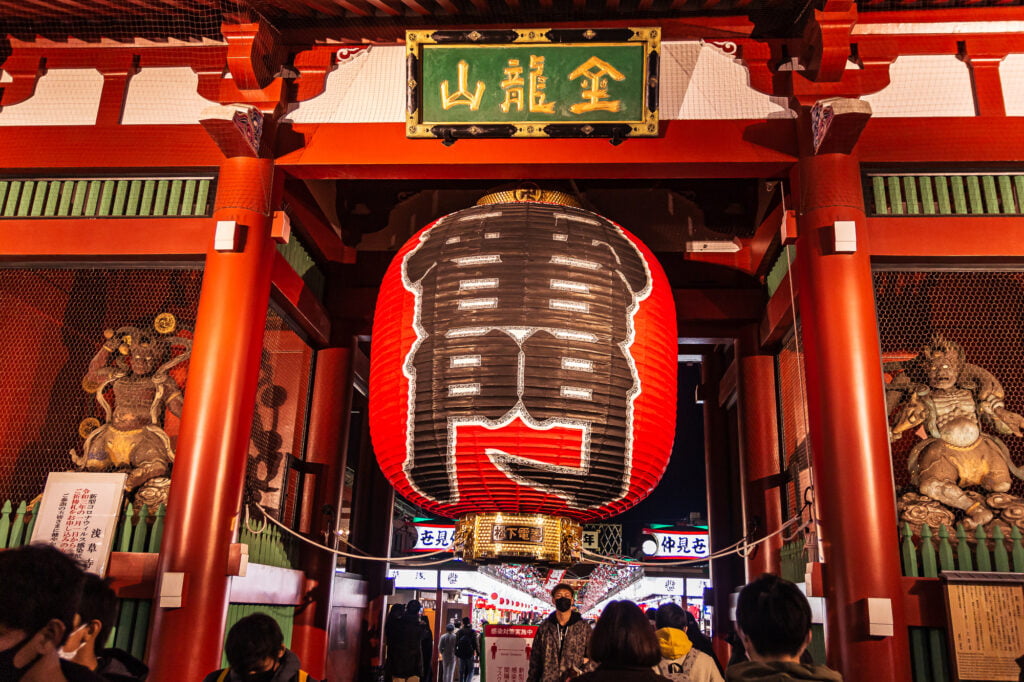
As you stroll around the corner from Asakusa station, a grand spectacle unfolds before your eyes – the Kaminarimon Gate. This iconic structure not only serves as a symbol of Asakusa but also proudly stands as the primary gateway to Senso-ji Temple. Officially known as the “Fuu-rai-jin-mon,” the gate’s name carries profound meaning, with “Fuu” representing wind and “Rai” signifying lightning. Adorning each side of the gate are statues representing these elemental forces, both held in deep reverence within the temple’s sacred precincts. The Kaminarimon offers a splendid opportunity to appreciate the exquisite craftsmanship and vibrant colors of such statues, a common sight in Japanese temples.
The Kaminarimon Gate itself is a remarkable architectural marvel, measuring 11.4 meters in width and 11.7 meters in height. At its focal point, a renowned lantern takes center stage, weighing an impressive 700 kilograms. This lantern typically hangs throughout the year, casting its gentle glow upon all who pass beneath it. However, during the festive Sanja-matsuri, a principal celebration of Asakusa Shrine, this colossal lantern is carefully rolled up and stored away. Visiting the Kaminarimon Gate during the Sanja-matsuri festival is an experience of great value, allowing you to immerse yourself in the lively atmosphere and cherished traditions of this local event. Whether you come to admire the gate’s artistic treasures or partake in the spirited festivities, the Kaminarimon Gate promises an unforgettable encounter at the heart of Asakusa.
Main Hall and Five-Story Pagoda
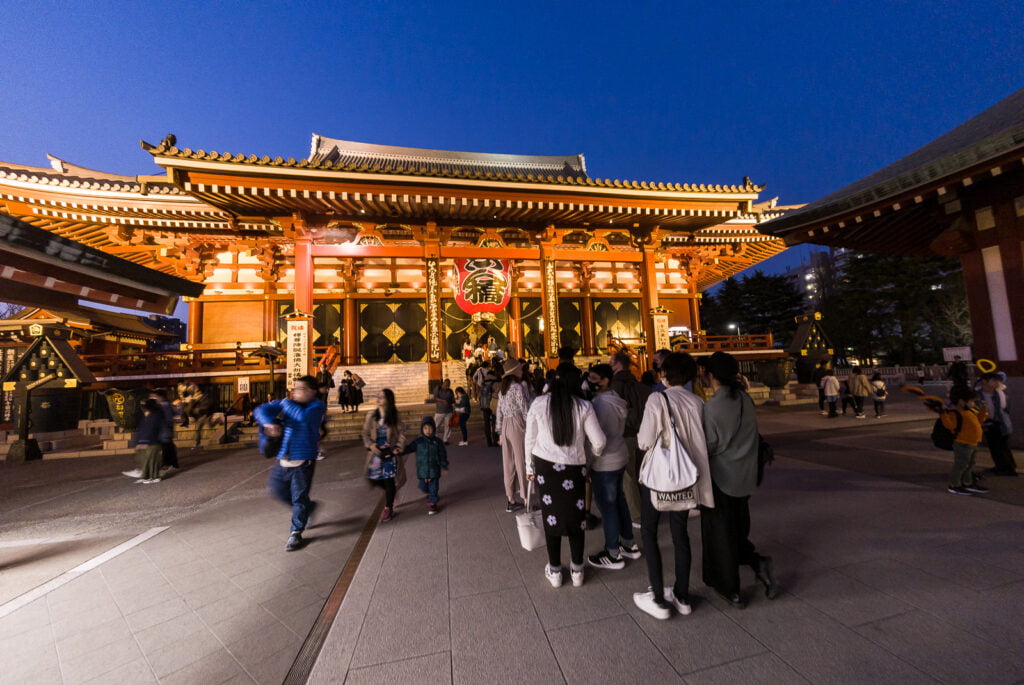
Beyond the second gate lies the very heart and soul of the temple, the Hondo. Within the realm of Japanese temples, the Hondo holds profound significance. It serves as the sacred sanctuary for the legendary Buddha statue, a treasure of immeasurable spiritual value. The Hondo, painstakingly reconstructed in 1649, stands as a testament to architectural resilience, having endured nearly three centuries without a scratch, ultimately achieving the esteemed status of a National Treasure. Yet, the cataclysmic bombings of 1945 brought about its complete destruction.
In its place now stands a symbol of modern engineering prowess, a structure meticulously crafted from reinforced concrete. This resilient edifice not only pays homage to the enduring spirit of Japanese temples but also embodies their remarkable capacity to adapt and rebuild. It ensures that the legacy of the Hondo and the sacred Buddha statue it enshrines will persist for generations to come.
Adjacent to Hozomon, the formidable gateway of Sensoji Temple, stands a towering architectural marvel known as Gojuu no tou. Such awe-inspiring structures are a common sight at Japanese temples. This particular tower, as its name suggests, proudly boasts five distinctive layers, earning it the revered title of “Goju no to,” signifying the “tower of five layers.” What elevates this tower to even greater prominence is its role as the custodian of a sacred relic—the Busshari, which cradles the ashes of the Buddha himself. These precious remains were graciously gifted by the Isurumuniya shrine in Sri Lanka and are tenderly enshrined at the pinnacle of the tower, intensifying the spiritual significance of this revered site.
Omikuji
Immerse yourself in the enchanting tradition of omikuji at revered Japanese temples such as Senso-ji. For a mere 100 yen, you can partake in this delightful ritual. Simply place your coin into the collection box and then give the omikuji box a gentle shake, savoring the charming “shaka shaka” sound that ensues. As the omikuji rod emerges, revealing the auspicious number 88, you are directed to the corresponding drawer, where you can retrieve your fortune slip. The thrill of the moment knows no bounds, especially when your result turns out to be as splendid as “daikichi,” signifying excellent luck! Bask in the joy of this moment, and witness the admiration of others as they share in the good fortune bestowed upon you by Senso-ji—a truly blessed experience for all.
Shokoro
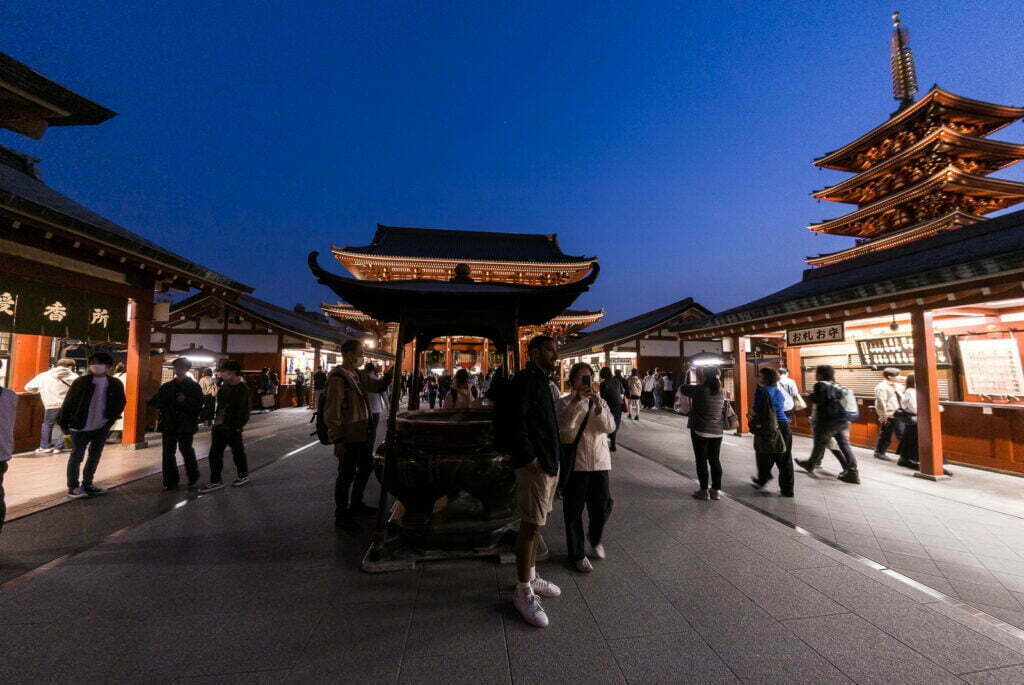
Situated between the imposing Hozomon and the sacred Hondo lies a substantial incense pot, a cherished sanctuary for offerings by visitors. You are cordially invited to partake in this revered ritual. Approach the pot, and you’ll observe people gently wafting the fragrant smoke towards themselves. According to ancient legend, directing this aromatic smoke towards any ailing part of your body may beckon future healing. It’s also believed that passing through the enveloping fragrant smoke serves as a purification rite, a sacred prelude to entering the hallowed Hondo, marking a spiritual journey toward sanctity. Embrace this timeless tradition at the core of Japanese temples, where the aroma of incense carries with it both solace and the promise of hope.
Nakamise Shopping Street: Timeless Commerce
A Glimpse into History
Nakamise, one of Japan’s most ancient shopping districts, traces its roots back to the Edo era, a period fueled by the burgeoning population of Edo (now Tokyo) and the influx of pilgrims and tourists visiting Sensoji Temple. It was during the years 1688 to 1735 that local residents who served the temple were granted the privilege of setting up shops along the temple’s approach, marking the inception of Nakamise. This bustling district quickly flourished, with establishments like “Yakudana” tea houses and shops near Kaminari-mon offering a wide array of goods, including toys, sweets, and souvenirs.
However, the Meiji Restoration brought significant changes. Temples lost their lands, and Nakamise merchants found themselves subjected to government regulations. By 1885, the Tokyo government mandated that the traditional merchants vacate the area, making way for the emergence of modern Western-style brick shops. Despite these challenges, Nakamise managed to endure, even overcoming natural disasters. Post-World War II, it adopted a Momoyama-style appearance, and it continues to be a vibrant 250-meter-long street adorned with electric signboards and seasonal decorations, captivating visitors from all corners of the world with its unique blend of tradition and modernity.
Traditional Crafts and Modern Souvenirs
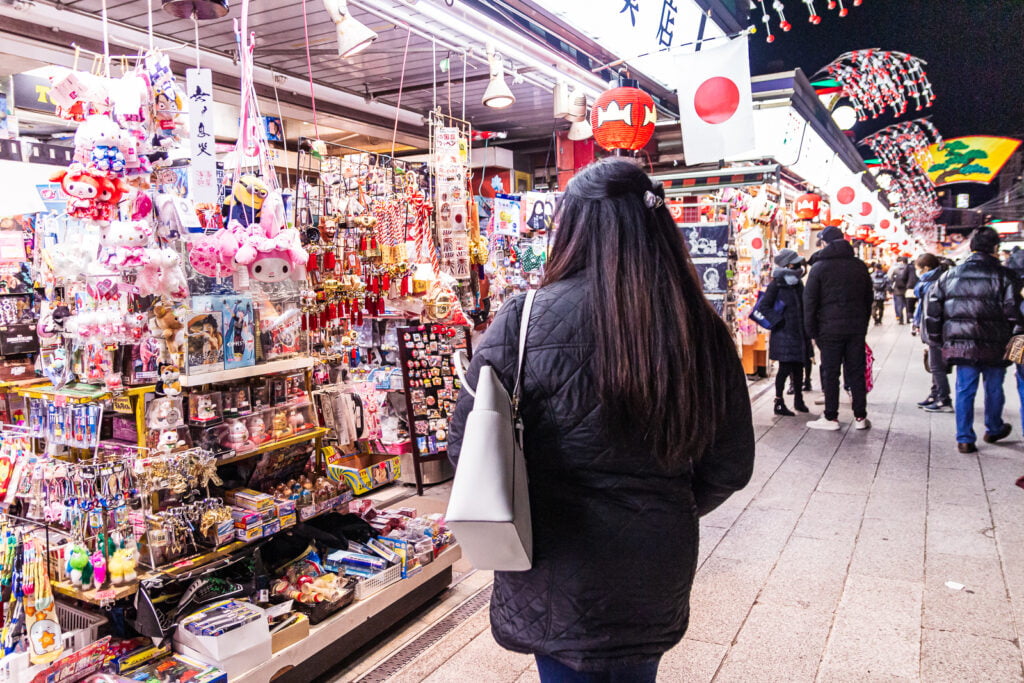
Nakamise Street is a treasure trove of traditional crafts and modern souvenirs. From intricately crafted folding fans and calligraphy brushes to contemporary trinkets and textiles, visitors can take a piece of Japanese culture home with them.
Culinary Delights: Street Food Galore
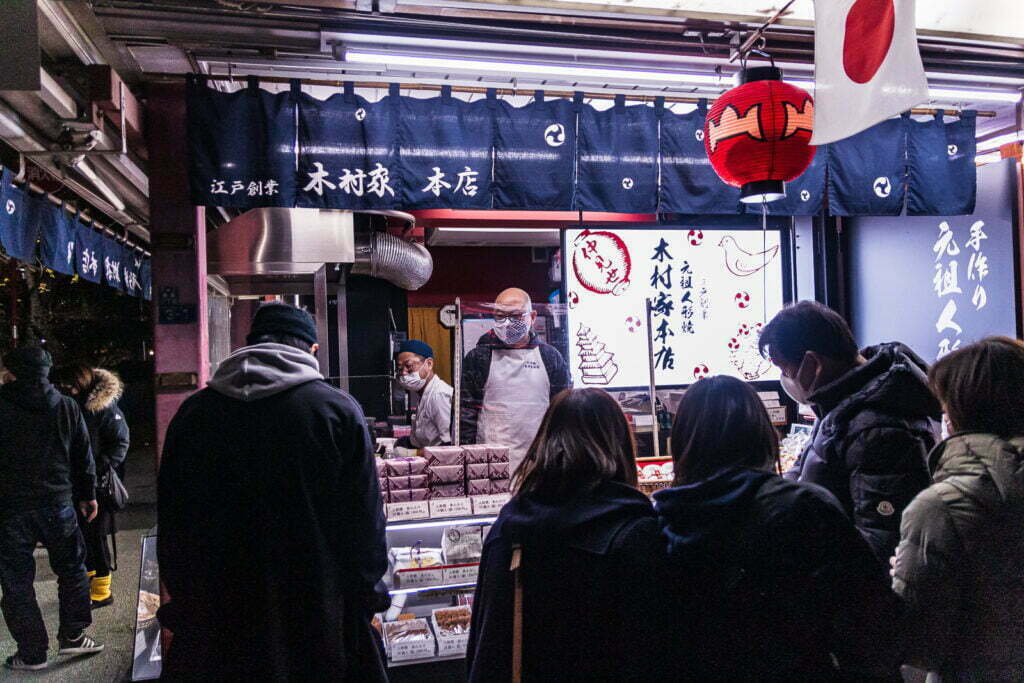
A visit to Nakamise Street would be incomplete without savoring its delightful street food offerings. This bustling thoroughfare presents a diverse range of flavors that tantalize the taste buds, from sweet indulgences like ningyo-yaki (doll-shaped cakes) to savory delights like senbei (rice crackers). It’s a culinary adventure that promises to delight all your senses.
You may also like to read: Exploring Tokyo: Unveiling Top Attractions and Hidden Gems
A Symbiotic Relationship
Tradition and Modernity in Unison
The remarkable synergy between Senso-ji Temple and Nakamise Shopping Street stands as a testament to Tokyo’s exceptional talent for harmoniously blending tradition and modernity. The temple’s profound spiritual significance finds perfect companionship in the lively commerce of Nakamise Street, resulting in an immersive experience that caters to a diverse array of visitors.
Spiritual Souvenirs and Symbolic Items
Nakamise Street offers more than just material goods; it provides an avenue for pilgrims and visitors to acquire spiritual souvenirs and symbolic items. These tokens not only serve as mementos of their visit but also as a lasting reminder of the sacred ambiance that envelops the temple.
A Hub of Cultural Exchange
Senso-ji Temple and Nakamise Street serve as a hub of cultural exchange. Visitors from around the world gather here, connecting with Japanese traditions and artisans, while locals witness the appreciation of their heritage by visitors from afar.
Visitor Experience: Embracing the Journey
Arrival and First Impressions
As visitors make their way toward Senso-ji Temple, they are greeted by the grandeur of the Kaminarimon Gate, a symbolic entrance into a realm where time-honored traditions beckon. The lively and bustling energy of Nakamise Street stands in striking contrast to the serene ambiance of the temple, together crafting a holistic and enriching experience for all who venture here.
Exploring the Temple Grounds
Within the temple grounds lies a sanctuary for peaceful contemplation. Here, visitors have the opportunity to partake in sacred rituals, including purifying themselves at the chozuya, a traditional water basin, and offering fragrant incense at the main hall. These practices allow individuals to immerse themselves in the profound spiritual atmosphere that envelops the temple, fostering a sense of inner tranquility and connection.
Meandering Through Nakamise Street
Wandering along Nakamise Street is akin to embarking on a journey through history. The charming traditional storefronts and vibrant displays extend a warm invitation to visitors, encouraging them to delve deeper and discover the hidden treasures that await within.
You may also like to read: Tokyo Travel Tips : How to Experience the Best of the City in Just 24 Hours!
Balancing Spirituality and Consumerism
Finding Tranquility Amidst Bustling Streets
The coexistence of spiritual serenity and vibrant commerce at Senso-ji and Nakamise Street serves as a poignant reflection of Tokyo’s remarkable talent for striking a harmonious balance between the spiritual and material dimensions of life.
Supporting Local Businesses and Artisans
Acquiring souvenirs and handcrafted items from Nakamise Street not only enables visitors to carry a part of Japan with them but also contributes to the sustenance of local businesses and artisans. These individuals play a pivotal role in safeguarding and passing on the rich tapestry of cultural heritage.
Navigating the Intersection of Culture and Commerce
Senso-ji Temple and Nakamise Shopping Street provide a distinct opportunity to traverse the crossroads of culture and commerce. Here, visitors have the chance to participate in spiritual rituals, admire the artistry of traditional craftsmanship, and immerse themselves in the vibrant atmosphere of a historic shopping street, all within the same enchanting destination.
You may also like to read: Tokyo Tower: Panoramic City Views
Access
Train
- Ginza Line Asakusa Station
- Major Stations on the Same Line: Ueno, Nihonbashi, Ginza, Omotesando, Shibuya
- Toei Asakusa Line Asakusa Station
- Major Stations on the Same Line: Narita Airport, Haneda Airport, Oshiage (Skytree), Shinagawa (Shinkansen)
- Tobu Asakusa Station
- Major Stations on the Same Line: Nikko, Kinugawa Onsen
- Tsukuba Express Asakusa Station
- Major Stations on the Same Line: Akihabara, Tsukuba
Hours
- April to September: 6:00 am to 5:00 pm
- October to March: 6:30 am to 5:00 pm
Fees
Free
Conclusion
Senso-ji Temple and Nakamise Shopping Street stand as a remarkable testament to Tokyo’s remarkable capacity to seamlessly fuse history with modernity, spirituality with commerce. Together, they create a multi-faceted experience that appeals to a diverse range of visitors—pilgrims seeking spiritual solace, travelers with a thirst for exploration, and culture enthusiasts eager to immerse themselves in Japan’s rich heritage. In this harmonious coexistence of tradition and progress, visitors unveil the beating heart of Tokyo’s captivating soul.
More from AirashiJapan
Navigating Tokyo Transportation efficiently
Tokyo Shibuya Crossing: The World’s Busiest Intersection
Exploring Tokyo: Unveiling Top Attractions and Hidden Gems
Kichijoji: Unveiling the Charm of Tokyo’s Hidden Gem
Yanaka: Old-World Charm and Quaint Streets
The Mystical Allure of the Torii Gate: A Gateway to Japanese Culture
Meiji Shrine: Journeying Through Tokyos Meiji Shrine
Exploring the Heart of Tokyo: Shinjuku

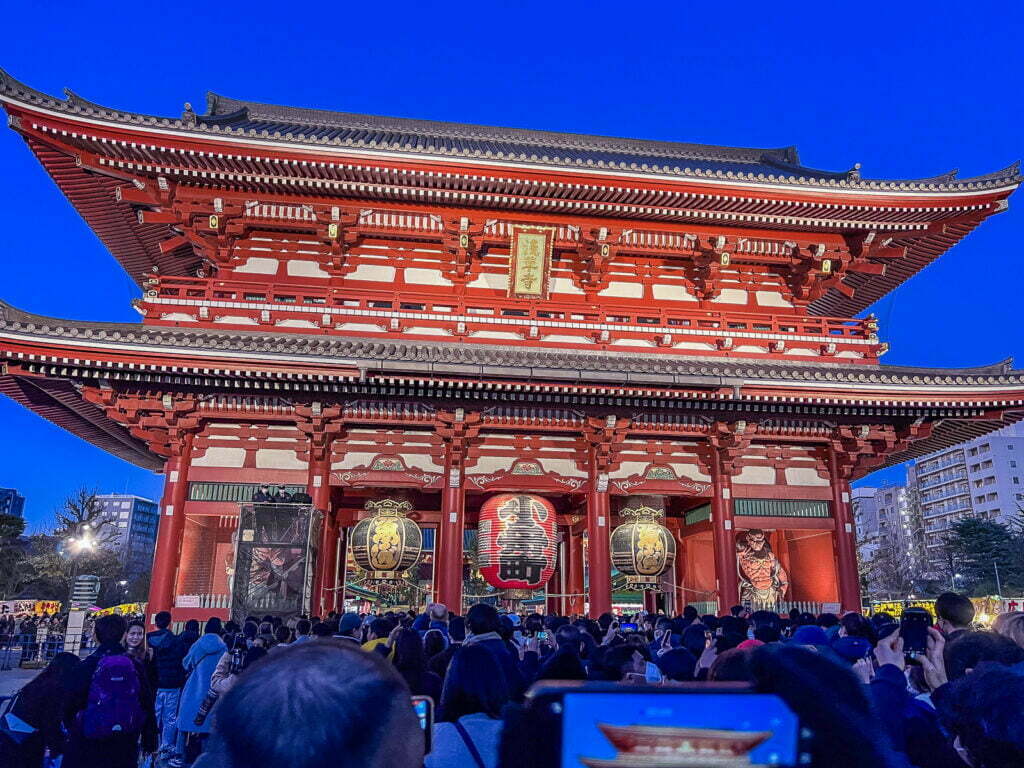
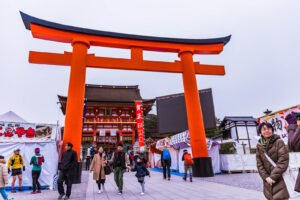



Pingback: Omoide Yokocho: Tokyo’s Nostalgic Alley of Memories - airashijapan.com
Pingback: Akihabara Electric Town : Tech and Anime Haven - airashijapan.com
Pingback: Exploring the Heart of Tokyo: Shinjuku - airashijapan.com
Pingback: Harajuku Japan: A Trendsetter’s Haven - airashijapan.com
Pingback: Navigating Tokyo Transportation efficiently - airashijapan.com
Pingback: Spring in Tokyo: Sakura Dreams at Shinjuku Gyoen - airashijapan.com
Pingback: Harajuku St: Where Tokyo Street Photography Comes Alive - airashijapan.com
Pingback: Best Places to See Autumn Foliage in Tokyo - airashijapan.com
Pingback: The Mystical Allure of the Torii Gate: A Gateway to Japanese Culture - airashijapan.com
Pingback: Yanaka: Old-World Charm and Quaint Streets - airashijapan.com
Pingback: Best Japan Travel Apps - airashijapan.com
Pingback: Recommended Reading for Your Journey to Japan - airashijapan.com
Pingback: Roppongi Tokyo: Fusion Hub of Culture and Nightlife - airashijapan.com